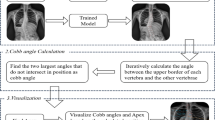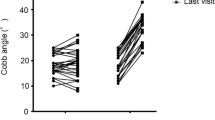Abstract
Objectives
To develop a deep learning algorithm to automatically evaluate and diagnose scoliosis on full spinal X-ray images.
Methods
This retrospective study collected full spinal X-ray images (anteroposterior) from four hospital databases from January 1, 2018, to March 31, 2021. The data were divided into training and validation sets. Full spinal X-ray images for external validation were independently collected at one hospital from April 1, 2021, to June 30, 2021. Model effectiveness was validated with a public dataset. Statistical software R was used to analyze the accuracy and sensitivity of the model curvature and anatomical balance parameters and assess interrater consistency.
Results
This study included 788 and 185 training and test datasets, respectively. The accuracy and recall of the algorithm model for the Cobb angle, apical vertebrae (AV), upper vertebrae, and lower vertebrae were 89.36%, 85.71%, 77.2%, and 80.24% and 97.35%, 93.38%, 84.11%, and 87.42%, respectively. The symmetric mean absolute percentage error at the Cobb angle was 5.99%, and the automatic measurement time was 1.7 s. The mean absolute error values of the Cobb angle and the distances between the center sacral vertical line and AV and C7 plumb line were 1.07° and 1.12 and 1.38 mm, respectively. Statistical analysis confirmed that the Cobb angle results were in good agreement with the gold standard (interclass coefficients of 0.996, 0.978, and 0.825; p < 0.001).
Conclusion
Our deep learning algorithm model had high sensitivity and accuracy for scoliosis, which could help radiologists improve their diagnostic efficiency.
Key Points
• Our deep learning algorithm model had high sensitivity and accuracy for scoliosis, which could help radiologists improve their diagnostic efficiency.
• Multi-center validation data were used in this study to guarantee the reliability of the research.
• Algorithmic model measures 200 times faster than radiologists.






Similar content being viewed by others

Abbreviations
- AIS:
-
Adolescent idiopathic scoliosis
- AV:
-
Apical vertebrae
- AVT:
-
Apical vertebral translation
- CAD:
-
Computer-aided diagnosis
- CNN:
-
Convolutional neural network
- CVA:
-
Coronal vertical axis
- ICC:
-
Intraclass correlation coefficients
- LV:
-
Lower vertebrae
- MAE:
-
Mean absolute error
- MSE-Net:
-
Multi-stage ensemble network
- SMAPE:
-
Symmetric mean absolute percentage error
- UV:
-
Upper vertebrae
References
Dunn J, Henrikson NB, Morrison CC, Blasi PR, Nguyen M, Lin JS (2018) Screening for adolescent idiopathic scoliosis: evidence report and systematic review for the US Preventive Services Task Force. JAMA 319:173–187
Lo YF, Huang YC (2017) Bracing in adolescent idiopathic scoliosis. Hu Li Za Zhi 64:117–123
Yang J, Xie M, Hu C et al (2021) Deep learning for detecting cerebral aneurysms with CT angiography. Radiology 298:155–163
Litjens G, Kooi T, Bejnordi BE et al (2017) A survey on deep learning in medical image analysis. Med Image Anal 42:60–88
Larson DB, Chen MC, Lungren MP, Halabi SS, Stence NV, Langlotz CP (2018) Performance of a deep-learning neural network model in assessing skeletal maturity on pediatric hand radiographs. Radiology 287:313–322
Liu K, Li Q, Ma J et al (2019) Evaluating a fully automated pulmonary nodule detection approach and its impact on radiologist performance. Radiol Artif Intell 1:e180084
Ueda D, Yamamoto A, Nishimori M et al (2019) Deep learning for MR angiography: automated detection of cerebral aneurysms. Radiology 290:187–194
Arbabshirani MR, Fornwalt BK, Mongelluzzo GJ et al (2018) Advanced machine learning in action: identification of intracranial hemorrhage on computed tomography scans of the head with clinical workflow integration. NPJ Digit Med 1:9
Cicero M, Bilbily A, Colak E et al (2017) Training and validating a deep convolutional neural network for computer-aided detection and classification of abnormalities on frontal chest radiographs. Invest Radiol 52:281–287
Yang J, Zhang K, Fan H et al (2019) Development and validation of deep learning algorithms for scoliosis screening using back images. Commun Biol 2:390
Dubost F, Collery B, Renaudier A et al (2019) Automated estimation of the spinal curvature via spine centerline extraction with ensembles of cascaded neural networks[C]//International Workshop and Challenge on Computational Methods and Clinical Applications for Spine Imaging. Springer, Cham pp 88–94
Zhong Z, Li J, Zhang Z et al (2019) A coarse-to-fine deep heatmap regression method for adolescent idiopathic scoliosis assessment[C]//International Workshop and Challenge on Computational Methods and Clinical Applications for Spine Imaging. Springer, Cham, pp 101–106
Zhao S, Wang B, Yang K et al (2019) Automatic spine curvature estimation by a top-down approach[C]//International Workshop and Challenge on Computational Methods and Clinical Applications for Spine Imaging. Springer, Cham, pp 75–80
Malfair D, Flemming AK, Dvorak MF et al (2010) Radiographic evaluation of scoliosis: review. AJR Am J Roentgenol 194:S8–S22
Chung N, Cheng YH, Po HL et al (2018) Spinal phantom comparability study of Cobb angle measurement of scoliosis using digital radiographic imaging. J Orthop Translat 15:81–90
Cobb J (1948) Outline for the study of scoliosis. Instr Course Lect AAOS 5:261–275
Anitha H, Prabhu GK (2012) Automatic quantification of spinal curvature in scoliotic radiograph using image processing. J Med Syst 36:1943–1951
Wang J, Sun K, Cheng T et al (2021) Deep high-resolution representation learning for visual recognition. IEEE Trans Pattern Anal Mach Intell 43:3349–3364
Russakovsky O, Deng J, Su H et al (2015) ImageNet large scale visual recognition challenge. Int J Comput Vis 115:211–252
Kyrölä KK, Salme J, Tuija J, Tero I, Eero K, Arja H (2018) Intra- and interrater reliability of sagittal spinopelvic parameters on full-spine radiographs in adults with symptomatic spinal disorders. Neurospine 15:175–181
Lenke LG, Betz RR, Harms J et al (2001) Adolescent idiopathic scoliosis: a new classification to determine extent of spinal arthrodesis. J Bone Joint Surg Am. 83:1169–1181
Yılmaz H, Zateri C, Kusvuran Ozkan A, Kayalar G, Berk H (2020) Prevalence of adolescent idiopathic scoliosis in Turkey: an epidemiological study. Spine J. 20:947–955
Wang L, Xie C, Lin Y et al (2021) Evaluation and comparison of accurate automated spinal curvature estimation algorithms with spinal anterior-posterior X-ray images: the AASCE2019 Challenge. Medical Image Analysis 72:102115
Wu H, Bailey C, Rasoulinejad P, Li S (2018) Automated comprehensive adolescent idiopathic scoliosis assessment using MVC-Net. Med Image Anal. 48:1–11
Wang H, Zhang T, Cheung KM, Shea GK (2021) Application of deep learning upon spinal radiographs to predict progression in adolescent idiopathic scoliosis at first clinic visit. EClinicalMedicine 42:101220
Chen B, Xu Q, Wang L, Leung S, Chung J, Li S (2019) An automated and accurate spine curve analysis system in IEEE Access. pp 124596–124605
Renganathan G, Manaswi N, Ghionea I, Cukovic S (2021) Automatic vertebrae localization and spine centerline extraction in radiographs of patients with adolescent idiopathic scoliosis. Stud Health Technol Inform. 281:288–292
Galbusera F, Niemeyer F, Wilke HJ et al (2019) Fully automated radiological analysis of spinal disorders and deformities: a deep learning approach. Eur Spine J 28:951–960
Watanabe K, Aoki Y, Matsumoto M (2019) An application of artificial intelligence to diagnostic imaging of spine disease: estimating spinal alignment from Moiré images. Neurospine 16:697–702
Kokabu T, Kanai S, Kawakami N et al (2021) An algorithm for using deep learning convolutional neural networks with three dimensional depth sensor imaging in scoliosis detection. Spine J 21:980–987
Zhang J, Li H, Lv L, Zhang Y (2017) Computer-aided Cobb measurement based on automatic detection of vertebral slopes using deep neural network. Int J Biomed Imaging 2017:9083916
Horng MH, Kuok CP, Fu MJ, Lin CJ, Sun YN (2019) Cobb angle measurement of spine from X-ray images using convolutional neural network. Comput Math Methods Med 2019:6357171
Acknowledgements
We thank Baotou Central Hospital, The First Affiliated Hospital of Baotou Medical College, The Affiliated Hospital of Inner Mongolia Medical University, and The Second Affiliated Hospital of Inner Mongolia Medical University for their assistance. Thank you all doctors for your hard work, thank you engineers of AI Lab, Deepwise & League of PhD Technology for your full support.
Funding
Science and technology project in Inner Mongolia, China (2019GG115). 2021 Zhiyuan Talent Project of Inner Mongolia Medical University; Innovation Team Development Plan of Inner Mongolia Education Department(NMGIRT2227); Inner Mongolia Natural Science Foundation (2020MS08124); Inner Mongolia “Grassland Talents” Youth Innovation and Entrepreneurship Talents Project (2020).
Author information
Authors and Affiliations
Corresponding author
Ethics declarations
Guarantor
The scientific guarantor of this publication is Xiaohe Li, Chao Wu.
Conflict of interest
The authors of this manuscript declare no relationships with any companies whose products or services may be related to the subject matter of the article.
Statistics and biometry
Cobb angles were evaluated by accuracy, symmetric mean absolute percentage error (SMAPE), mean absolute error (MAE), and consistency. Consistency was calculated with intraclass correlation coefficients (ICCs). AVT and CVA were evaluated using ICC and MAE. The Kendall coefficient was used to evaluate vertebral location consistency.
Informed consent
Written informed consent was not required for this study because this study is a retrospective study.
Ethics approval
This study was approved by the Ethics Committee of Inner Mongolia Medical University (YKD2019GG115).
Methodology
• multicentre study
Additional information
Publisher’s note
Springer Nature remains neutral with regard to jurisdictional claims in published maps and institutional affiliations.
Chao Wu and Gedong Meng are co-first authors.
Supplementary information
ESM 1
(DOCX 21 kb)
Rights and permissions
About this article
Cite this article
Wu, C., Meng, G., Lian, J. et al. A multi-stage ensemble network system to diagnose adolescent idiopathic scoliosis. Eur Radiol 32, 5880–5889 (2022). https://doi.org/10.1007/s00330-022-08692-9
Received:
Revised:
Accepted:
Published:
Issue Date:
DOI: https://doi.org/10.1007/s00330-022-08692-9



